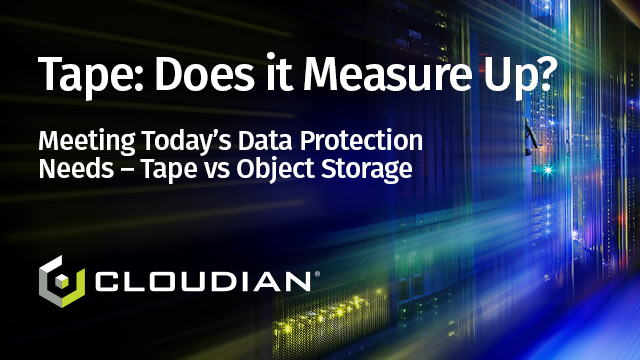Data storage on magnetic tape media has a long history that extends back to the earliest days of digital computing in the last century. Even with the great advancements made across all areas of computing and data processing in recent decades, traditional LTO tape still provides a valuable role as an inexpensive storage medium that can retain data for long periods with little or no power input. As such, many organizations still employ data tape as one part of their total data protection plan, which is diversified across multiple technologies.
But for all of its advantages, data tape has several inherent drawbacks in comparison to spinning disk solutions, and chief among them is accessibility. By its very nature, data tape is an offline storage format, meaning that data must be restored from tape into an online data storage platform before being read or modified. The lack of immediate and complete accessibility has driven many organizations with large data sets to embrace cloud-native solutions, such as object storage, for all of their unstructured data.

As organizations across the world grapple with the explosion of data being created within their domains, many storage managers are finding themselves at a turning point as they try to keep up. Should we soldier on with our legacy data tape infrastructure and continue to cope with all of the challenges that come with it? Or should we blaze a trail towards all things ‘cloudy’, whether that’s private cloud, public cloud, or some hybrid version of the two? Regardless of the chosen data center modernization strategy, the precise details of how to get legacy data migrated to a next-generation solution are non-trivial and require thorough planning.
As with any major technology shift, there are important factors to consider when planning for a migration from data tape to cloud object storage. Is all of the data being moved wholesale in one operation, or is it a phased migration over time? Does the legacy data require any inspections or transformations before being committed to object storage? Is it beneficial to enrich the metadata of the assets via AI/ML during migration? The answers to these questions can range widely from simple and straightforward to complex and variable. The good news is that the problem is not unique, and there are expert resources to help organizations formulate a migration plan that minimizes disruptions.
At Cloudian our alliance team has worked very diligently in recent years to make sure we are tested and qualified with the leading partner solutions in order to help our customers achieve their digital transformation goals.
Some partners offer a full-service soup-to-nuts migration planning and execution service that will handhold customers through the entire process, while others offer SaaS-based solutions that can orchestrate massive-scale asset migrations from legacy on-prem archive systems to a next-generation cloud object storage solution. Either way, customers get to choose the right fit to ensure the fastest and most efficient transition while ensuring existing production workflows are not impacted.
For data stored on LTFS format tapes, our partner NODEUM offers a platform that can index the entire LTFS data set and perform a controlled migration to Cloudian object storage. In the media and entertainment space, we have several partner solutions that specialize in media asset archives, with Telestream DIVA, Masstech Kumulate, and StorageDNA DNAfabric being the market leaders. With metadata enrichment being such a desirable aspect of the data migration process, it is no surprise that all of these solutions offer some degree of automated metadata creation as part of the workflow, be it speech-to-text transcription, image and facial recognition, or technical information.
Regardless of the platform or migration process details, organizations typically find immediate operational benefits after transitioning to a scalable object storage archive that is online and accessible anywhere via the S3 API.
Tape: Does it Measure Up?
For more information, please view this webinar.



